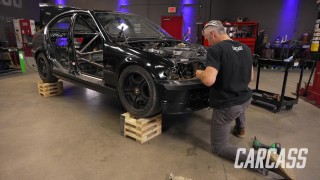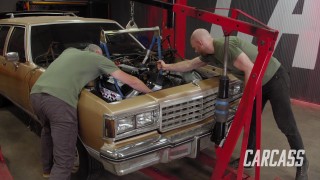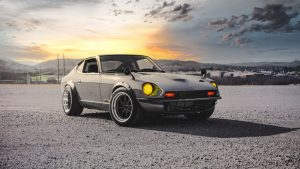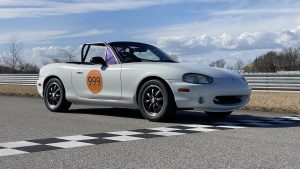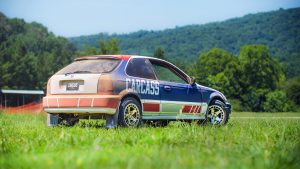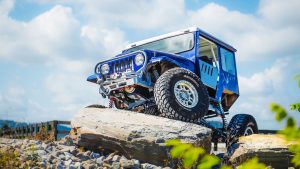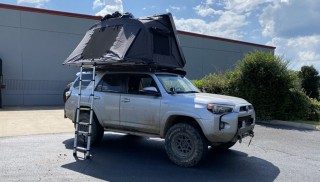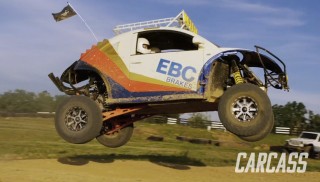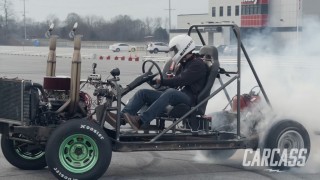Carcass Featured Projects
Carcass Builds
Want more content like this?
Join the PowerNation Email NewsletterParts Used In This Episode
American Powertrain Systems
Tremec Magnum 6-Speed Manual Transmission
Holley
Holley Terminator X Max
Holley
Street Fire Coil Packs
Matco Tools
MATCO Tools are the Official Tool Supplier to PowerNation
PowerTrain Products
Chevy 6.0 LQ9 Stage 2 LS Engine
The Industrial Depot
Tools, Hardware, Shop Supplies
Episode Transcript
(Jeremy)>> You're watching Powernation!
(Jimmy)>> Today on Carcass we're ripping through the clipping points.
(Jeremy)>> But before we can do that we're adding some go fast goodies to push us past the 500 horsepower threshold.
(Narrator)>> When you want to build something different you turn to Carcass. They transform cars and trucks into one of a kind builds. From street to mud, if you dream it they can build it. This is Carcass, a non-traditional speed shop. [ MUSIC ]
(Jeremy)>> We're about half way done transforming our stock Trailblazer SS into a four door drifting machine that you can bring the whole family along for a ride.
(Jimmy)>> We started by ripping out everything on the inside, constructing a roll cage for safety. Then we added some lightweight racing seats from Summit Racing and a custom console.
(Jeremy)>> We ditched the old engine with 230,000 miles on it and replaced it with a brand new LQ-9 from Powertrain Products.
(Jimmy)>> We paired that with a Magnum 6-speed from American Powertrain that will give us better control when we're in a slide.
(Jeremy)>> And that slide wouldn't be possible without a drifting hand brake from Summit Racing, and a homemade shifter that matches our personalities to a "T".
(Jimmy)>> With the interior out of the way we turned our attention to the looks department, crafting a carbon fiber hood the same shape and size as the original along with a custom wrap that gives our Trailblazer that drift car look.
(Jeremy)>> Yeah you're right, a supercharger would be crazy on this thing but I think we should get into the suspension before we even think about the engine bay again.
(Jimmy)>> I agree but before we start taking all this stuff apart I think we should mount the new wheels and tires just to get a feel for what mods we're gonna have to make. [ drill humming ]
(Jeremy)>> Well what do you think?
(Jimmy)>> I think it looks a whole lot better but there's still some work we've got to do in regards to suspension.
(Jeremy)>> Yeah, we really don't want our wheels cambered like that.
(Jimmy)>> We'll figure something out. Now our o-e setup is not the best for a drifting vehicle. When you're at full steering lock the outside tire cambers out, reducing the amount of contact that the tread has with the ground, and since you're generally in those full steering lock positions throughout a slide it's not the best.
(Jeremy)>> We have a lot we need to disassemble before we can access the upper control arms on our front end. The wheels need to come off and then we need to unbolt the tie rod end and give it a few... [ metal clanging ]
(Jeremy)>> Well a lot of blows with the hammer.
(Jimmy)>> We'll tackle the brakes next. We need to remove the caliper bolts. Slipping it off the rotor and hanging it up, preventing our brake line from getting damaged. This is followed by the rotor, which comes off without any blunt force.
(Jeremy)>> Something that does need a little bit of muscle is the upper ball joint mount but it's nothing Jimmy and a hammer can't solve.
(Jimmy)>> And with the upright free from the upper ball joint we'll tackle the lower next, tapping the whole knuckle free from the vehicle. We can then unbolt the strut, easily lifting it away.
(Jeremy)>> Finally we need to tackle the upper control arm. We'll need to unbolt both sides working the wrench in some awkward spaces, and even though we're not modifying the lower control arm we'll remove it for good measure because after 230,000 miles the bushings in these were less than ideal.
(Jimmy)>> Our wheel wells are now empty leaving us with a clean canvas to rebuild our front suspension. The lower control arms go in first, securing them using the stock bolts. The mounting holes on our strut towers need to be hogged out to match the rod ends on our new upper control arms. So we'll do that before installing the coil overs, which use the stock strut yoke to slip onto the lower control arm. With those linked to each other we can raise our coil over into position.
(Jeremy)>> With that all in place we can add our newly fabbed upper control arms. An extra pair of hands help line up these grade eight bolts, which can be a little stubborn. With the remaining spacer, a lock washer, and matching nut the arms can be snugged up on each side.
(Jimmy)>> The upright can then be installed. It slips onto the lower control arm and is then married to the upper control arm. We'll then need to connect the sway bar, followed by the wheel speed sensor. The new rotors can go on next along with the stock caliper.
(Jeremy)>> With everything in place we can start tightening the nuts and bolts to everything.
(Jimmy)>> That completes our front end suspension upgrades but it'd be all for nothing if we didn't touch on the rear as well. So we'll disassemble the rear suspension starting with the tired shocks.
(Jeremy)>> Then we'll lower the axle to relax our worn out springs, which we'll quickly replace. Then we can add our new shocks, add our brake upgrades along with new pads, and snug everything up. Up next we get back to work on our drifting Trailblazer. We're adding some go fast goodies to push us past the 500 horsepower threshold.
(Jimmy)>> Our burnout king is getting into the final stages of this build and this four door drifting Trailblazer is almost ready to meet the clipping points.
(Jeremy)>> Now our truck is going to roar down track but we want to add a little bit of whine to that rumble. So we picked up a power adder from the guys over at Vortec Superchargers, but before we can add all of that we want to upgrade our fuel and ignition system.
(Jimmy)>> Now we're going to work back to front, attacking the fuel pump first. We'll need to disconnect all the fuel lines including the filler neck hose before we bring in a transmission jack to assist in removing the tank. [ MUSIC ]
(Jeremy)>> From here we can remove the retaining ring, and carefully remove the stock pump. [ MUSIC ]
(Jimmy)>> With a quick measurement...
(Jeremy)>> 8 inches.
(Jimmy)>> ...we can remove the fuel pump hanger rod from the assembly, and cut it to length on the band saw.
(Jeremy)>> The hanger rod is then reattached to the pump so we can cut the inlet and return lines to their proper length. We'll tackle the inlet first using the brown covered inlet spout for reference.
(Jimmy)>> With it trimmed down we can connect the pump to the inlet hose and add the fuel sock.
(Jeremy)>> Lastly we'll trim the return line so it's not too long. Now our new pump differs from our o-e pump in two different ways. First off this is a return style system, which sends unused fuel back to the tank. Our original only supplied just enough to keep the engine running. So there was no need for a return line but it isn't enough for the power upgrades we want to add. Second the original pump ran at 250 liters per hour at 58 p-s-i and this one provides 450 liters at 90 p-s-i. So a huge flow increase over the stock one, and plenty for the power adder we're throwing at it. [ drill humming ]
(Jimmy)>> With the tank installed we can move on to our fuel lines. We'll need to install a pressure regulator between the engine and fuel pump.
(Jeremy)>> With that in place we can attach the return line, inlet line, and the line that will feed the engine. Holley sent us all of our dash six hoses and fittings.
(Jimmy)>> With the pressure regulator plumbed up we can feed our supply line up to the engine, snaking it along the bottom and up through the engine bay. We'll gauge its length at the fuel rail and cut it to length.
(Jeremy)>> All there's left to do is add the quick connect fitting from Holley and make the connection at the fuel rail, supplying enough fuel for our power adder. Our drift Trailblazer has gotten all the fuel and spark upgrades it needs and now it's time to add a proper supercharger.
(Jimmy)>> The blower we picked out is a centrifugal Vortec supercharger that pairs with LS engines. It comes with all the spacers and piping you need for the install. To kick start this install we have to do some disassembly first. The entire front drive essentially has to come off. This includes things like the alternator, front drive bracket, and the water pump.
(Jeremy)>> With everything pretty much off the front of the engine we can move on to the Vortec kit. Now there's a number of things we need to set on there before we can actually install the blower. We'll start with the harmonic damper. In this application this part will have a lot more force applied by the belt than usual. To keep it from spinning on the crankshaft we'll use a drill bit with a cheap depth guide and the provided drilling jig from the blower kit to key the damper to the crankshaft. The provided pin will keep these clocked in the same position.
(Jimmy)>> With that keyed we can add the damper bolt and torque it down to 250 pound feet.
(Jeremy)>> Let's put the bracket on. That's not gonna work.
(Jimmy)>> I think if we maybe cut it right here and then if we need to we'll re-drill and tap a hole for the support and put it somewhere in there.
(Jeremy)>> Now we need to make a small mod to the bracket that holds on the supercharger. I'm not too worried about making this cut because this is a beefy bracket and there are a ton of bolts that hold this together. Let's do a test fit. Let's see how this is all gonna play out.
(Jimmy)>> Looking better already.
(Jeremy)>> We've got clearance Clarence.
(Jimmy)>> That's one hurdle out of the way, and that one small mod works so far but now we need to see if the supercharger is actually gonna fit.
(Jeremy)>> Let's see how this fits then. Nope that's not a good sign. This kit is not made for our Trailblazer SS. So we've got to make another mod but that's as simple as grabbing a cutoff wheel and getting rid of a little bit of the inner fender. Let's see how close we are or aren't. Where's that go there?
(Jimmy)>> Think we got a winner?
(Jeremy)>> I think we did.
(Jimmy)>> With a few simple mods the supercharger is now resting where it should be but we still have a lot to do before we can call this job done. The pulley for the supercharger still needs to be installed along with the tensioner pulley, which will keep the belt from flying off. With the installation of the remaining pulleys we can finally test fit everything to make sure it all lines up.
(Jeremy)>> That's a good test fit right there.
(Jimmy)>> Yeah everything looks like it lines up. So we can go back, tighten everything on this system, try to get the front of the motor back together.
(Jeremy)>> A few odds and ends remain. We need to hook up the oil feed line to the supercharger, the Corvette power steering pump needs to go in, the alternator needs to be installed, and we'll slap on the water pump.
(Jimmy)>> With the front drive buttoned up we'll add the charge pipe, which will send all that boost to the engine.
(Jeremy)>> With the front end going together on our Trailblazer we're ready to lay down some numbers on the dyno. [ engine revving ]
(Jimmy)>> We came down to visit our buddies in Engine Power because they have a chassis dyno that's gonna allow us to properly measure how much horsepower we're making at the tire. [ MUSIC ]
(Jeremy)>> Alright guys it's altogether. What do you think?
(Pat)>> I really like it, and I'm digging the hot charge. That's old school.
(Mike)>> This thing being a GM s-u-v guy I love it, but it reminds me of a modern day Mad Max truck. The wicked graphics, the blower with no intercooler. What you guys did inside this truck with the cage and the safety features and everything on it, I'm a huge fan.
(Jeremy)>> That was all Jimmy's idea.
(Jimmy)>> I'm just excited because I've never done anything boosted and I have no idea what kind of power it's gonna make.
(Pat)>> Well these things are decent from the factory right, and this one sounded like it had a little bit of a cam in it from Powertrain Products. With a little bit of boost you're gonna be surprised.
(Mike)>> Hot charge, what do you think, 15, 20 horse per pound of boost?
(Pat)>> Yeah we're not used to doing a lot of hot charge stuff. So we're gonna find out.
(Jeremy)>> Well speaking of finding out I get to sit in the driver's seat but I've never done this before. So you guys are just gonna have to.
(Pat)>> We're gonna babysit you, but it starts off with getting in.
(Mike)>> Go plant your butt in the hot seat. [ MUSIC ]
(Jeremy)>> Alright I'm in the driver's seat, first time, what do I do?
(Pat)>> You're gonna take the brake off. You're gonna get it up rolling and you're gonna get it all the way up into fourth gear, and then at your start r-p-m you're gonna stab the throttle and hit the green button, and that's how it acquires data. You're gonna run it up to your top r-p-m, whatever you want to stop at, and then you take your foot off the gas. Do not hit the vehicle's brake lever. The red is the brake. So you take your foot off the gas pedal and then clutch and click it up into neutral, and then when you stop we'll acquire the data. The biggest thing is it's gonna be a little jumpy, it's gonna be a little hard to get used to. Just don't hit the brake pedal on the vehicle, that's it.
(Jeremy)>> Foot away from that.
(Pat)>> Run it up to your r-p-m and make sure you have it all the way to the floor. It's easy when you first start to not push it all the way to the floor. That's what you do on this thing, and you don't have to steer. All you have to look at is your tach. You'll get it. It'll take a little bit to get used to but you'll be fine.
(Jeremy)>> We'll get it. [ engine starting ]
(Pat)>> Alright you ready?
(Jeremy)>> Let's try it!
(Pat)>> Take your brake off and let her buck.
(Jeremy)>> Red button's off, first gear, here we go! [ MUSIC ] [ engine revving ] [ MUSIC ]
(Pat)>> Okay are you ready? First hit 493.99, torque is 465, and that is at 5.47 pounds.
(Jeremy)>> We've still got more to go!
(Pat)>> There's plenty more to go.
(Mike)>> Next run what I want you to do is bring the starting point of the sweep up. So start at 3,000, and you pulled it to 6,000 that time, pull it to 6,500.
(Jeremy)>> Okay!
(Mike)>> Alright it's all you. [ engine revving ]
(Pat)>> Oh baby, that wasn't bad right there! Yeah there it is, 518, 487 pound feet. Dude that's nice!
(Jimmy)>> On our second run we gained 25 horsepower and 22 pound feet of torque, but I think a third run will do us some good because the Terminator-X kit is still doing some self-learning. [ engine revving ]
(Pat)>> That's pretty nasty right there.
(Mike)>> That's it!
(Pat)>> Nice, nice, nice, 529 horse, it broke 500 on torque, 505.89 pound feet.
(Jeremy)>> Bam son, bam!
(Pat)>> I would say that's as close to probably making 600 at the crank as you can get.
(Jeremy)>> I think it's gonna be a handful the way it is. I think we're good. What do you think Jimmy?
(Jimmy)>> I'd say so yeah.
(Pat)>> Remember there's no such thing as too much power just not enough driver.
(Jeremy)>> That's totally me.
(Pat)>> No that's in my case!
(Mike)>> Another good dyno day!
(Jimmy)>> Appreciate it fellas!
(Pat)>> Dyno days are my favorite!
(Mike)>> 529!
(Jimmy)>> Up next we take 529 ponies to the track and wear out some tires through the clipping points.
(Jeremy)>> It's a lovely day here in Bowling Green, Kentucky, and we're here at NCM Motorsports Park where they have an incredible road course and a giant paddock area for us to do some testing and tuning.
(Jimmy)>> And members of their driving club get 32 days a year dedicated just to them to really open up the throttle and have some fun with their own vehicles, and that's exactly what we're gonna do today.
(Jeremy)>> We laid down just over 100 cones so we can take out our 529 horsepower Trailblazer for a little spin. [ tires squealing ]
(Jimmy)>> Let's go over the rules for our drifting challenge and see how the points will be awarded.
(Jeremy)>> And to keep this unbiased our producer's gonna be the one awarding and tallying up the points. Now the first set of points are gonna be who can maintain the closest proximity to our clipping zones. There's four clipping zones, one point per zone.
(Jimmy)>> Second, one point will be awarded in regards to style. Whoever can go through the course most gracefully maintaining the most angle while transitioning in and out of the turns.
(Jeremy)>> And the last two points are gonna be awarded to whoever can get through the course without spinning out or straightening out in the least amount of tries.
(Jimmy)>> Pretty much whoever can learn the fastest.
(Jeremy)>> And this guy's going first. [ MUSIC ]
(Jimmy)>> I took off on my first run with just a basic idea of how to start a slide, and to no surprise I spun out. In my second attempt I felt a little more confident but I felt like I had to go a little bit faster to nail the slide, but it happened again, and again, and again. [ tires squealing ]
(Jeremy)>> After 31 failed attempts Jimmy's determination drove him to link this entire course together. Now I just hope I can do it in let's say under 40.
(Jimmy)>> With Jeremy behind the wheel I'd like to think he learned something from me but something tells me he's just an all-around good driver. [ tires squealing ]
(Jeremy)>> While our producer is tallying up the points Jimmy, how do you think you did?
(Jimmy)>> Pretty good I think. So 31 tries and two hours for me to complete the course, which I think is pretty good for someone who doesn't know how to drift, but in terms of how close I got to the clipping zones I have no idea.
(Jeremy)>> It's too hard to really tell the clipping zones when you're in the truck. The truck kinda does everything it wants to do on its own. We just don't have enough seat time to really make this work. Alright points are in. He's got her all tallied up. How many runs did I do it in? I did it in 12, and I got 2 points, and you did it in 31. Style points, well you got 1 point for style and there's just a big honking zero next to me. So I didn't even get any points but I agree with that cause you transitioned way better between all your clipping points, and then clipping zones I got a point and then you got 3 points, and that's obviously.
(Jimmy)>> No way!
(Jeremy)>> Well that's how close we got to the cones and stuff. You had a really smooth run. Oh my gosh, I lost again! How's that even possible!
(Jimmy)>> On the year I think that's 3 wins for me?
(Jeremy)>> Yeah and I got 3 points and you got 4 points, but I got 2 extra points cause my run was quicker.
(Jimmy)>> I think overall you're better at drifting than I am. You picked it up faster.
(Jeremy)>> Disappointing!
(Jimmy)>> Awesome! We just got back from the track paying off our Trailblazer SS and we had a ton of fun trying to learn how to drift, but we wanted to give you guys some insight on a future project that we kinda already started working on.
(Jeremy)>> This is our 1977 Chevy C-30 tow truck that Jimmy and I rescued out of a junkyard. Now we are absolutely in love with the patina look of this truck but you're gonna notice something. The doors are missing. Well we had a chance to take the doors off and send them out to the guys over at Wyotech. Now their custom paint department is gonna keep the patina look on the doors but put a little Carcass spin on it.
(Jimmy)>> Meet Mike Fisher. He's the street rod instructor at Wyotech and he's the man who's gonna give our doors that Carcass look, but before we dive into his craft let's take a look at what makes Wyotech a leading vocational school for auto technicians.
(Jeremy)>> Wyotech has a ton to offer when it comes to the automotive programs. Programs like street rod, chassis fabrication, automotive technology, diesel technology, collision and refinishing, trim and upholstery, and even applied service management all stay on the bleeding edge of technology, which results in their graduates entering the work force with the most up to date knowledge.
(Jimmy)>> And instructors like Mike teach aspiring technicians to do some incredible work. Take our tow truck doors for example. Mike takes meticulous care masking off the doors and then uses special spray brush techniques to blend the Carcass logo into the door. This unique knowledge is handed down to the students allowing them to create masterpieces like this, and then they enter the workforce learning from experienced instructors who can teach them the tips and tricks of the trade.
(Jeremy)>> The guys over at Wyotech did a great job on the doors, and it's definitely gonna give our tow truck and little bit of class.
(Jimmy)>> So if you want to follow along with this build or get any more information go to Powernation TV dot com.
(Jeremy)>> What do you say we clean the truck out?
(Jimmy)>> Maybe lunch first.
(Jeremy)>> I'm gonna go to lunch!
Show Full Transcript
(Jimmy)>> Today on Carcass we're ripping through the clipping points.
(Jeremy)>> But before we can do that we're adding some go fast goodies to push us past the 500 horsepower threshold.
(Narrator)>> When you want to build something different you turn to Carcass. They transform cars and trucks into one of a kind builds. From street to mud, if you dream it they can build it. This is Carcass, a non-traditional speed shop. [ MUSIC ]
(Jeremy)>> We're about half way done transforming our stock Trailblazer SS into a four door drifting machine that you can bring the whole family along for a ride.
(Jimmy)>> We started by ripping out everything on the inside, constructing a roll cage for safety. Then we added some lightweight racing seats from Summit Racing and a custom console.
(Jeremy)>> We ditched the old engine with 230,000 miles on it and replaced it with a brand new LQ-9 from Powertrain Products.
(Jimmy)>> We paired that with a Magnum 6-speed from American Powertrain that will give us better control when we're in a slide.
(Jeremy)>> And that slide wouldn't be possible without a drifting hand brake from Summit Racing, and a homemade shifter that matches our personalities to a "T".
(Jimmy)>> With the interior out of the way we turned our attention to the looks department, crafting a carbon fiber hood the same shape and size as the original along with a custom wrap that gives our Trailblazer that drift car look.
(Jeremy)>> Yeah you're right, a supercharger would be crazy on this thing but I think we should get into the suspension before we even think about the engine bay again.
(Jimmy)>> I agree but before we start taking all this stuff apart I think we should mount the new wheels and tires just to get a feel for what mods we're gonna have to make. [ drill humming ]
(Jeremy)>> Well what do you think?
(Jimmy)>> I think it looks a whole lot better but there's still some work we've got to do in regards to suspension.
(Jeremy)>> Yeah, we really don't want our wheels cambered like that.
(Jimmy)>> We'll figure something out. Now our o-e setup is not the best for a drifting vehicle. When you're at full steering lock the outside tire cambers out, reducing the amount of contact that the tread has with the ground, and since you're generally in those full steering lock positions throughout a slide it's not the best.
(Jeremy)>> We have a lot we need to disassemble before we can access the upper control arms on our front end. The wheels need to come off and then we need to unbolt the tie rod end and give it a few... [ metal clanging ]
(Jeremy)>> Well a lot of blows with the hammer.
(Jimmy)>> We'll tackle the brakes next. We need to remove the caliper bolts. Slipping it off the rotor and hanging it up, preventing our brake line from getting damaged. This is followed by the rotor, which comes off without any blunt force.
(Jeremy)>> Something that does need a little bit of muscle is the upper ball joint mount but it's nothing Jimmy and a hammer can't solve.
(Jimmy)>> And with the upright free from the upper ball joint we'll tackle the lower next, tapping the whole knuckle free from the vehicle. We can then unbolt the strut, easily lifting it away.
(Jeremy)>> Finally we need to tackle the upper control arm. We'll need to unbolt both sides working the wrench in some awkward spaces, and even though we're not modifying the lower control arm we'll remove it for good measure because after 230,000 miles the bushings in these were less than ideal.
(Jimmy)>> Our wheel wells are now empty leaving us with a clean canvas to rebuild our front suspension. The lower control arms go in first, securing them using the stock bolts. The mounting holes on our strut towers need to be hogged out to match the rod ends on our new upper control arms. So we'll do that before installing the coil overs, which use the stock strut yoke to slip onto the lower control arm. With those linked to each other we can raise our coil over into position.
(Jeremy)>> With that all in place we can add our newly fabbed upper control arms. An extra pair of hands help line up these grade eight bolts, which can be a little stubborn. With the remaining spacer, a lock washer, and matching nut the arms can be snugged up on each side.
(Jimmy)>> The upright can then be installed. It slips onto the lower control arm and is then married to the upper control arm. We'll then need to connect the sway bar, followed by the wheel speed sensor. The new rotors can go on next along with the stock caliper.
(Jeremy)>> With everything in place we can start tightening the nuts and bolts to everything.
(Jimmy)>> That completes our front end suspension upgrades but it'd be all for nothing if we didn't touch on the rear as well. So we'll disassemble the rear suspension starting with the tired shocks.
(Jeremy)>> Then we'll lower the axle to relax our worn out springs, which we'll quickly replace. Then we can add our new shocks, add our brake upgrades along with new pads, and snug everything up. Up next we get back to work on our drifting Trailblazer. We're adding some go fast goodies to push us past the 500 horsepower threshold.
(Jimmy)>> Our burnout king is getting into the final stages of this build and this four door drifting Trailblazer is almost ready to meet the clipping points.
(Jeremy)>> Now our truck is going to roar down track but we want to add a little bit of whine to that rumble. So we picked up a power adder from the guys over at Vortec Superchargers, but before we can add all of that we want to upgrade our fuel and ignition system.
(Jimmy)>> Now we're going to work back to front, attacking the fuel pump first. We'll need to disconnect all the fuel lines including the filler neck hose before we bring in a transmission jack to assist in removing the tank. [ MUSIC ]
(Jeremy)>> From here we can remove the retaining ring, and carefully remove the stock pump. [ MUSIC ]
(Jimmy)>> With a quick measurement...
(Jeremy)>> 8 inches.
(Jimmy)>> ...we can remove the fuel pump hanger rod from the assembly, and cut it to length on the band saw.
(Jeremy)>> The hanger rod is then reattached to the pump so we can cut the inlet and return lines to their proper length. We'll tackle the inlet first using the brown covered inlet spout for reference.
(Jimmy)>> With it trimmed down we can connect the pump to the inlet hose and add the fuel sock.
(Jeremy)>> Lastly we'll trim the return line so it's not too long. Now our new pump differs from our o-e pump in two different ways. First off this is a return style system, which sends unused fuel back to the tank. Our original only supplied just enough to keep the engine running. So there was no need for a return line but it isn't enough for the power upgrades we want to add. Second the original pump ran at 250 liters per hour at 58 p-s-i and this one provides 450 liters at 90 p-s-i. So a huge flow increase over the stock one, and plenty for the power adder we're throwing at it. [ drill humming ]
(Jimmy)>> With the tank installed we can move on to our fuel lines. We'll need to install a pressure regulator between the engine and fuel pump.
(Jeremy)>> With that in place we can attach the return line, inlet line, and the line that will feed the engine. Holley sent us all of our dash six hoses and fittings.
(Jimmy)>> With the pressure regulator plumbed up we can feed our supply line up to the engine, snaking it along the bottom and up through the engine bay. We'll gauge its length at the fuel rail and cut it to length.
(Jeremy)>> All there's left to do is add the quick connect fitting from Holley and make the connection at the fuel rail, supplying enough fuel for our power adder. Our drift Trailblazer has gotten all the fuel and spark upgrades it needs and now it's time to add a proper supercharger.
(Jimmy)>> The blower we picked out is a centrifugal Vortec supercharger that pairs with LS engines. It comes with all the spacers and piping you need for the install. To kick start this install we have to do some disassembly first. The entire front drive essentially has to come off. This includes things like the alternator, front drive bracket, and the water pump.
(Jeremy)>> With everything pretty much off the front of the engine we can move on to the Vortec kit. Now there's a number of things we need to set on there before we can actually install the blower. We'll start with the harmonic damper. In this application this part will have a lot more force applied by the belt than usual. To keep it from spinning on the crankshaft we'll use a drill bit with a cheap depth guide and the provided drilling jig from the blower kit to key the damper to the crankshaft. The provided pin will keep these clocked in the same position.
(Jimmy)>> With that keyed we can add the damper bolt and torque it down to 250 pound feet.
(Jeremy)>> Let's put the bracket on. That's not gonna work.
(Jimmy)>> I think if we maybe cut it right here and then if we need to we'll re-drill and tap a hole for the support and put it somewhere in there.
(Jeremy)>> Now we need to make a small mod to the bracket that holds on the supercharger. I'm not too worried about making this cut because this is a beefy bracket and there are a ton of bolts that hold this together. Let's do a test fit. Let's see how this is all gonna play out.
(Jimmy)>> Looking better already.
(Jeremy)>> We've got clearance Clarence.
(Jimmy)>> That's one hurdle out of the way, and that one small mod works so far but now we need to see if the supercharger is actually gonna fit.
(Jeremy)>> Let's see how this fits then. Nope that's not a good sign. This kit is not made for our Trailblazer SS. So we've got to make another mod but that's as simple as grabbing a cutoff wheel and getting rid of a little bit of the inner fender. Let's see how close we are or aren't. Where's that go there?
(Jimmy)>> Think we got a winner?
(Jeremy)>> I think we did.
(Jimmy)>> With a few simple mods the supercharger is now resting where it should be but we still have a lot to do before we can call this job done. The pulley for the supercharger still needs to be installed along with the tensioner pulley, which will keep the belt from flying off. With the installation of the remaining pulleys we can finally test fit everything to make sure it all lines up.
(Jeremy)>> That's a good test fit right there.
(Jimmy)>> Yeah everything looks like it lines up. So we can go back, tighten everything on this system, try to get the front of the motor back together.
(Jeremy)>> A few odds and ends remain. We need to hook up the oil feed line to the supercharger, the Corvette power steering pump needs to go in, the alternator needs to be installed, and we'll slap on the water pump.
(Jimmy)>> With the front drive buttoned up we'll add the charge pipe, which will send all that boost to the engine.
(Jeremy)>> With the front end going together on our Trailblazer we're ready to lay down some numbers on the dyno. [ engine revving ]
(Jimmy)>> We came down to visit our buddies in Engine Power because they have a chassis dyno that's gonna allow us to properly measure how much horsepower we're making at the tire. [ MUSIC ]
(Jeremy)>> Alright guys it's altogether. What do you think?
(Pat)>> I really like it, and I'm digging the hot charge. That's old school.
(Mike)>> This thing being a GM s-u-v guy I love it, but it reminds me of a modern day Mad Max truck. The wicked graphics, the blower with no intercooler. What you guys did inside this truck with the cage and the safety features and everything on it, I'm a huge fan.
(Jeremy)>> That was all Jimmy's idea.
(Jimmy)>> I'm just excited because I've never done anything boosted and I have no idea what kind of power it's gonna make.
(Pat)>> Well these things are decent from the factory right, and this one sounded like it had a little bit of a cam in it from Powertrain Products. With a little bit of boost you're gonna be surprised.
(Mike)>> Hot charge, what do you think, 15, 20 horse per pound of boost?
(Pat)>> Yeah we're not used to doing a lot of hot charge stuff. So we're gonna find out.
(Jeremy)>> Well speaking of finding out I get to sit in the driver's seat but I've never done this before. So you guys are just gonna have to.
(Pat)>> We're gonna babysit you, but it starts off with getting in.
(Mike)>> Go plant your butt in the hot seat. [ MUSIC ]
(Jeremy)>> Alright I'm in the driver's seat, first time, what do I do?
(Pat)>> You're gonna take the brake off. You're gonna get it up rolling and you're gonna get it all the way up into fourth gear, and then at your start r-p-m you're gonna stab the throttle and hit the green button, and that's how it acquires data. You're gonna run it up to your top r-p-m, whatever you want to stop at, and then you take your foot off the gas. Do not hit the vehicle's brake lever. The red is the brake. So you take your foot off the gas pedal and then clutch and click it up into neutral, and then when you stop we'll acquire the data. The biggest thing is it's gonna be a little jumpy, it's gonna be a little hard to get used to. Just don't hit the brake pedal on the vehicle, that's it.
(Jeremy)>> Foot away from that.
(Pat)>> Run it up to your r-p-m and make sure you have it all the way to the floor. It's easy when you first start to not push it all the way to the floor. That's what you do on this thing, and you don't have to steer. All you have to look at is your tach. You'll get it. It'll take a little bit to get used to but you'll be fine.
(Jeremy)>> We'll get it. [ engine starting ]
(Pat)>> Alright you ready?
(Jeremy)>> Let's try it!
(Pat)>> Take your brake off and let her buck.
(Jeremy)>> Red button's off, first gear, here we go! [ MUSIC ] [ engine revving ] [ MUSIC ]
(Pat)>> Okay are you ready? First hit 493.99, torque is 465, and that is at 5.47 pounds.
(Jeremy)>> We've still got more to go!
(Pat)>> There's plenty more to go.
(Mike)>> Next run what I want you to do is bring the starting point of the sweep up. So start at 3,000, and you pulled it to 6,000 that time, pull it to 6,500.
(Jeremy)>> Okay!
(Mike)>> Alright it's all you. [ engine revving ]
(Pat)>> Oh baby, that wasn't bad right there! Yeah there it is, 518, 487 pound feet. Dude that's nice!
(Jimmy)>> On our second run we gained 25 horsepower and 22 pound feet of torque, but I think a third run will do us some good because the Terminator-X kit is still doing some self-learning. [ engine revving ]
(Pat)>> That's pretty nasty right there.
(Mike)>> That's it!
(Pat)>> Nice, nice, nice, 529 horse, it broke 500 on torque, 505.89 pound feet.
(Jeremy)>> Bam son, bam!
(Pat)>> I would say that's as close to probably making 600 at the crank as you can get.
(Jeremy)>> I think it's gonna be a handful the way it is. I think we're good. What do you think Jimmy?
(Jimmy)>> I'd say so yeah.
(Pat)>> Remember there's no such thing as too much power just not enough driver.
(Jeremy)>> That's totally me.
(Pat)>> No that's in my case!
(Mike)>> Another good dyno day!
(Jimmy)>> Appreciate it fellas!
(Pat)>> Dyno days are my favorite!
(Mike)>> 529!
(Jimmy)>> Up next we take 529 ponies to the track and wear out some tires through the clipping points.
(Jeremy)>> It's a lovely day here in Bowling Green, Kentucky, and we're here at NCM Motorsports Park where they have an incredible road course and a giant paddock area for us to do some testing and tuning.
(Jimmy)>> And members of their driving club get 32 days a year dedicated just to them to really open up the throttle and have some fun with their own vehicles, and that's exactly what we're gonna do today.
(Jeremy)>> We laid down just over 100 cones so we can take out our 529 horsepower Trailblazer for a little spin. [ tires squealing ]
(Jimmy)>> Let's go over the rules for our drifting challenge and see how the points will be awarded.
(Jeremy)>> And to keep this unbiased our producer's gonna be the one awarding and tallying up the points. Now the first set of points are gonna be who can maintain the closest proximity to our clipping zones. There's four clipping zones, one point per zone.
(Jimmy)>> Second, one point will be awarded in regards to style. Whoever can go through the course most gracefully maintaining the most angle while transitioning in and out of the turns.
(Jeremy)>> And the last two points are gonna be awarded to whoever can get through the course without spinning out or straightening out in the least amount of tries.
(Jimmy)>> Pretty much whoever can learn the fastest.
(Jeremy)>> And this guy's going first. [ MUSIC ]
(Jimmy)>> I took off on my first run with just a basic idea of how to start a slide, and to no surprise I spun out. In my second attempt I felt a little more confident but I felt like I had to go a little bit faster to nail the slide, but it happened again, and again, and again. [ tires squealing ]
(Jeremy)>> After 31 failed attempts Jimmy's determination drove him to link this entire course together. Now I just hope I can do it in let's say under 40.
(Jimmy)>> With Jeremy behind the wheel I'd like to think he learned something from me but something tells me he's just an all-around good driver. [ tires squealing ]
(Jeremy)>> While our producer is tallying up the points Jimmy, how do you think you did?
(Jimmy)>> Pretty good I think. So 31 tries and two hours for me to complete the course, which I think is pretty good for someone who doesn't know how to drift, but in terms of how close I got to the clipping zones I have no idea.
(Jeremy)>> It's too hard to really tell the clipping zones when you're in the truck. The truck kinda does everything it wants to do on its own. We just don't have enough seat time to really make this work. Alright points are in. He's got her all tallied up. How many runs did I do it in? I did it in 12, and I got 2 points, and you did it in 31. Style points, well you got 1 point for style and there's just a big honking zero next to me. So I didn't even get any points but I agree with that cause you transitioned way better between all your clipping points, and then clipping zones I got a point and then you got 3 points, and that's obviously.
(Jimmy)>> No way!
(Jeremy)>> Well that's how close we got to the cones and stuff. You had a really smooth run. Oh my gosh, I lost again! How's that even possible!
(Jimmy)>> On the year I think that's 3 wins for me?
(Jeremy)>> Yeah and I got 3 points and you got 4 points, but I got 2 extra points cause my run was quicker.
(Jimmy)>> I think overall you're better at drifting than I am. You picked it up faster.
(Jeremy)>> Disappointing!
(Jimmy)>> Awesome! We just got back from the track paying off our Trailblazer SS and we had a ton of fun trying to learn how to drift, but we wanted to give you guys some insight on a future project that we kinda already started working on.
(Jeremy)>> This is our 1977 Chevy C-30 tow truck that Jimmy and I rescued out of a junkyard. Now we are absolutely in love with the patina look of this truck but you're gonna notice something. The doors are missing. Well we had a chance to take the doors off and send them out to the guys over at Wyotech. Now their custom paint department is gonna keep the patina look on the doors but put a little Carcass spin on it.
(Jimmy)>> Meet Mike Fisher. He's the street rod instructor at Wyotech and he's the man who's gonna give our doors that Carcass look, but before we dive into his craft let's take a look at what makes Wyotech a leading vocational school for auto technicians.
(Jeremy)>> Wyotech has a ton to offer when it comes to the automotive programs. Programs like street rod, chassis fabrication, automotive technology, diesel technology, collision and refinishing, trim and upholstery, and even applied service management all stay on the bleeding edge of technology, which results in their graduates entering the work force with the most up to date knowledge.
(Jimmy)>> And instructors like Mike teach aspiring technicians to do some incredible work. Take our tow truck doors for example. Mike takes meticulous care masking off the doors and then uses special spray brush techniques to blend the Carcass logo into the door. This unique knowledge is handed down to the students allowing them to create masterpieces like this, and then they enter the workforce learning from experienced instructors who can teach them the tips and tricks of the trade.
(Jeremy)>> The guys over at Wyotech did a great job on the doors, and it's definitely gonna give our tow truck and little bit of class.
(Jimmy)>> So if you want to follow along with this build or get any more information go to Powernation TV dot com.
(Jeremy)>> What do you say we clean the truck out?
(Jimmy)>> Maybe lunch first.
(Jeremy)>> I'm gonna go to lunch!







